
image by Eugene Ipavec, 14 September 2006

Last modified: 2008-07-19 by dov gutterman
Keywords: colombia | invias | ecopetrol |
Links: FOTW homepage |
search |
disclaimer and copyright |
write us |
mirrors
Ministries:
The Judicial System:
Other Governmental Organizations:
See also:

image by Eugene Ipavec, 14 September 2006
The flag of the Ministerio de Defensa Nacional (Ministry of
National Defense). Its official website located at <www.mindefensa.gov.co>.
E. R., 14 September 2006
Variant
I saw a picture showing a variant of the already existing flag
of the Ministry of National Defense. The flag includes the words
Ministerio de Defensa Nacional.
Source: <www.esinf.mil.co>.
E. R., 5 July 2007

image by Eugene Ipavec, 1 June 2006
Yesterday I saw a broadcast on TV of Minister Sabas Pretelt de
La Vega, the current Minister of Interior and Justice. On the
background there was the flag of this Ministry. The flag is the
Colombian tricolor, with the Coat of Arms on the middle, bordered
by a red fringe, with the words REPUBLICA DE COLOMBIA, in yellow,
capitals, inside the fringe, and on the bottom it reads
MINISTERIO DEL INTERIOR Y DE JUSTICIA, also in yellow.
The official websites of this Ministry are: <www.mininteriorjusticia.gov.co>,
<www.mij.gov.co>.
E. R., 1 June 2006
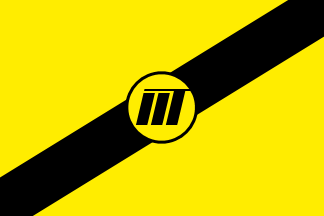
image by Eugene Ipavec, 8 July 2006
I recently saw on the entrance of the Airport Jose Maria
Cordova in the Municipality of RIonegro (Department of
Antioquia), the flag of the Ministerio de Transporte (Ministry of
Transportation). The flag is a horizontal shape flag, all yellow
(the same shade as the Colombian national flag) and it has a
black diagonal line going from the bottom hoist to the top fly.
The width of this stripe is the same as the small circular logo.
Official website:<www.mintrasnporte.gov.co>.
E. R., 19 June 2006
The Colombian Judicial system has four High Courts, which are:
- Corte Constitucional (Constitutional Court): Established by the
1991 Political Constitution, composed by seven Magistrates and
it's in charge of safekeeping the principles of the Constitution
and the Constitutionality of the administrative actions of the
government. Its official website is <www.constitucional.gov.co>
- Corte Suprema de Justicia (Supreme Court of Justice): Since the
Colombian first declaration of independence (July 20, 1810) and
the establishment of several independent States like Tunja (1811), Antioquia
(1812), Cartagena de Indias (1812) and
Cundinamarca (1812), each State had its
own organ in charge of the administration of justice. Later, when
several States established the Provincias Unidad de la Nueva
Granada (United Provinces on New Granada),
on September 23rd, 1814, the Alto Tribunal de Justicia (High
Tribunal of Justice) was established. Later during the Republic
of Colombia (better known as the Great
Colombia, a Court was created in the Constitution of 1821 of
August 30, named Alta Corte de Justicia (High Court of Justice).
Later, when the Great Colombia dissolved, the Republic of New Granada was formed, and on
its Constitution of 1832 of February 29, the Corte Suprema de
Justicia (Supreme Court) was established. Then on May 20, 1853
during the period of the Republic of New Granada, the Corte
Suprema de la Nación (Nation Supreme Court) is established. Then
during the period of the Grenadine
Confederation on the Constitution of 1858 of May 22, the
Courte Suprema (Supreme Court) was the organ in charge. Then
during the period of the Estados Unidos de Colombia (United States of Colombia) the
Constitution of May 8, 1863 established the Corte Suprema Federal
(Supreme Federal Court). Then on the establishment of the
República de Colombia (Republic of Colombia) on the Constitution
of August 4, 1886, the organ was renamed Corte Suprema de
Justicia (Supreme Court of Justice). This Court was based on the
Spanish Law of its Appeal Court of 1885, which at the same time
was inspired on the French Appeal Court. It currently is made up
of seven Magistrates.
- Consejo de Estado (Council of State): It was first established
by Simón Bolívar by Presidential Decree as President of the
Republic of Venezuela in the city of Angostura (now called Ciudad Bolívar , on the Department of
Bolivar, of the Republic of Venezuela), on October 30,
1817 and it was based on the same institution created by Napoleon
in France back in 1799. It was an organ that replaced the
citizens in the popular election bodies (democratic bodies) and
help to make decisions at a State level. On the 1821 Constitution
it worked as the Consejo de Gobierno (Government Council). On
August 27, 1828, under Decree by Simón Bolívar the rules for
the Consejo de Estado are established, changing only the number
of representatives in the 1830 Constitution . The 1832
Constitution changes the number of Representatives and also
establishes the Consejo de Gobierno. The 1843 Constitution
supresses the Consejo de Estado but allows the Consejo de
Gobierno, which remained during the 1858 Constitution as well.
During the periods of the Confederación Granadina (Grenadine
Confederation, 1856-1861), the Estados Unidos de Nueva Granada
(United States of New Granada, 1861) and the Estados Unidos de
Colombia (United States of Colombia, 1861-1886) there is no
mention of either the Consejo de Estado or Consejo de Gobierno.
In the 1886 Constittuion it reappears as Consejo de Estado
working as a consultant organ and also preparing the Acts to pass
to Congress. Later during the dictatorship of Rafael Reyes, the
Consejo de Estado was abolished by Constitutional Ammendment No.
10, of 1905. Then by Constitutional Ammendment of September 10,
1914 the establishment of the Consejo de Estado is permanent
being the highest consultant government body in terms of
administrative issues.
- Consejo Superior de la Judicatura (Judiciary Superior Council):
It was established in the Constitution of 1991, although several
attempts were made to establish an organ of such carachteristics
back in the 1970's and 1980's. It is in charge of the
administration of justice, that is, the supervision of all judges
around the country.
Source: Rama Judicial (Judiciary Branch) official
website at <www.ramajudicial.gov.co>.
E. R., 10 September 2006

image by Eugene Ipavec, 10 September 2006
I recently saw the flag of the Corte Constitucional
(Constitutional Court) of Colombia on August 15, 2006, on the TV
news channel Caracol
Noticias.
E. R., 10 September 2006

image by Eugene Ipavec, 20 December 2005
This Colombian governmental flag is very similar to the flag
of the Procuraduría General de la Nación. It
has the same ratio, and same white background. This government
organization is in charge of keeping accounting records as
control over public expenditures. The main building for this
government organization is located in Bogota, but it has branch
offices in all the 32 Departments and also in the main cities.
Source: Official website <www.contraloriagen.gov.co>.
E. R., 20 December 2005

image by Eugene Ipavec, 2 July 2006
This is the flag of a Colombian government organization named
Defensoría del Pueblo, which is the equivalent to the European
Ombudsman. The flag should be a plain white background with the
Emblem on the middle.
Official website at <www.defensoria.org.co>.
E. R., 2 July 2006
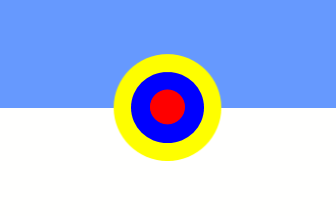
image by Eugene Ipavec, 9 November 2005

image by Eugene Ipavec, 9 November 2005

reverse
image by Eugene Ipavec, 2 March 2006
.jpg)
Coat of Arms
image contributed by E. R., 12 June 2005
Translated from <www.das.gov.co>
(located by Dov Gutterman): "On rectangular shape,
is formed by sky blue and white colors in two equal horizontal
bands, with sky blue on top and white on bottom, the national
tricolor will appear in circular 'cucarda' shape in the center of
the flag."
Departamento Administrativo de Seguridad (Administrative Security
Department), is Colombia's secret police, in charge of home land
security, immigration, emigration, bodyguards for public
servants, criminal investigations, etc.
Carlos Thompson, 5 November 2004
Coat of Arms of DAS (Security, Intelligence and Secret
Service) is taken from the book "Himnos y Símbolos de
Nuestra Colombia" , page 278. Written in 2000 by Julio Cesar
García, edited by Camer Editores. ISBN 958-33-1489-7.
E. R., 12 June 2005
There is an additional flag which has the same color pattern,
only with the DAS Coat of Arms in the middle.
E. R., 9 November 2005
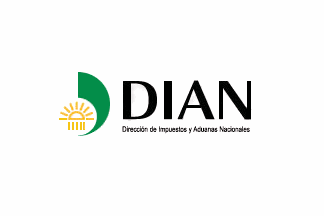
image by Eugene Ipavec, 6 March 2008
The flag DIAN (Dirección de Impuestos y Aduanas Nacionales,
or National Tariffs and Taxes Directorate). The DIAN has the
category of a Unidad Administrativa Especial (Special
Administrative Unit), same status as Aeorcivil.
The DIAN was formed by the merger of the DAN (Dirección de
Aduanas Nacionales, National Tariffs Directorate) and the DIN
(Dirección de Impuestos Nacionales, National Taxes Directorate),
on June 1, 1993, when Decree No. 2117 of 1992 entered into force.
The DIAN is in charge of the administration and control of
of national taxes and tariffs.
The flag is the DIAN's logo (seen on the official website) on a white
background.
Source: Screenshot of newspaper El Tiempo of its online
edition of February 4, 2008
E. R., 6 March 2008

image by Carlos Thompson, 5 November 2004

ceremonial flag
image by Carlos Thompson, 5 November 2004
dgp.gif)
emblem
image by Carlos Thompson, 5 November 2004
From <www.inpec.gov.co>:
"Mediante resolución Ministerial No. 3991 del 6 de
septiembre de 1965, sen adoptó la bandera de la Dirección
General de Prisiones, con las siguientes características:
La bandera estará compuesta por los colores blanco, rojo y
negro, distribuidos en tres franjas horizontales de iguales
dimensiones, de las cuales el blanco ocupará la superior, el
rojo la central y el negro la inferior. El color blanco
significará la purificación del individuo por la pena. El color
rojo, tenido como expresión del amor a la libertad, recordará
que aquella se conquista por la acción del trabajo. El color
negro evocará la austeridad e indicará que el
perfeccionamiento del hombre y su superación se logran con base
en el esfuerzo y constante disciplina.
La bandera del servicio de Prisiones que se ice en Pabellones,
deberá tener tres (3) metros de largo por dos (2) de ancho.
La bandera de Prisiones para desfiles tendrá un metro con
treinta y cinco (1.35) centímetros de largo, por un metro con
diez (1.10) centímetros de ancho. La bandera de desfiles
llevará en el centro un escudo que adopte como distintivo la
Dirección General de Prisiones.
La bandera estará confeccionada en seda suelta e irá sujeta al
asta por medio de un dobladillo o jareta amplia, hecho con la
misma tela."
Dov Gutterman, 26 May 2002
Flags of the General Prision Direction in Colombia (Dirección
General de Prisiones, known by their previous acronym: INPEC).
The flag for flying is 2 m. width by 3 m. long, and the
ceremonial flag is 1.10 m. width by 1.35 m. long, with the emblem
in the center. In the emblem, in the left side of the book
(dexter) is the following cite: "Con el estudio,
el trabajo y la disciplina romperás las cadenas del cautiverio,
porque el estudio eleva, el trabajo redime y la disciplina
libera". and around the legend says: "Ministerio de
Justicia y del Derecho - Instituto Nacional Penitenciario y
Carcelario" I don't know if this has changed, since
now the Ministry of Justice has merged with the Ministry of
Interior, and INPEC official name is Dirección Nacional de
Prisiones.
Carlos Thompson, 5 November 2004
INPEC stands for "Instituto Nacional Penitenciario y
Carcelario". It changed its name on5th of November, 2004.
However the abbreviation still stands even though the name
changed because people are more familair with it.
It is not a police force. They are allowed to wear uniforms, use
weapons and have custody of all prisons but they are not an
organizational part of the Colombian Police, they are under the
the Minister of Interior and Justice.
Here is INPEC's coat of arms
from the book "Himnos y Símbolos de Nuestra Colombia"
, page 277. Written in 2000 by Julio Cesar García, edited by
Camer Editores. ISBN 958-33-1489-7.
E. R., 12 June 2006

image by Luis Carrillo, 18 July 2002
Flag of Empresa Colombiana de Petróleos ECOPETROL.
Luis Carrillo, 18 July 2002
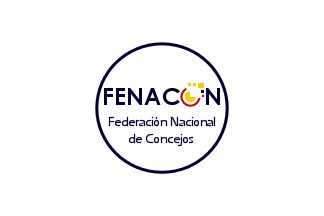
image by Eugene Ipavec, 14 october 2007
The flag of FENACON (Federación Nacional de Concejos), or
Councils' National Federation. "Council" is the
Legislative Branch of government in a Municipality in Colombia,
and the Federation is the gathering of the councilmen of (so far)
623 Municipalities' Councils. Image is baed on photo taken from
the official website
of the Colombian Ministry of National Defense. In the photo there
is the Colombian Defens Minister Juan Manuel Santos as he appears
in front of the Colombian flag (left) and the FENACON flag
(right), togheter with FENACON's current President Mauricio
Tobón, who is also the President of Medellín's Council.
FENACON official website is at <www.fenacon.org>.
E.R., 14 october 2007

image by Jaume Ollé, 30 May 2005
The flag of the Fiscalía General de la Nación (nation's
General Attorney). Official website at <www.fiscalia.gov.co>.
The purpose of the "Fiscalía" (as it is widely known
locally) is to investigate crimes and qualify the judicial
processes before judges and tribunals.
The logo, a puzzle piece, is oficially called "Pieza
clave" (it could be translated as "smoking gun",
or main proof) and it was created in 1996 (see <www.fiscalia.gov.co/entidad.html#logo>.
The image is based on the actual Fiscalía flag taken form the
official website.
E. R., 30 May 2005
fonade.jpg)
image from <web.fonade.gov.co>
There is a Colombian government company called FONADE (Fondo
Financiero de Proyectos de Desarrollo- Financial Fund for
Development Projects). It depends on the DNP (Departamento
Nacional de Planeación, or Nationa Planning Department). The DNP
stands at the same administrative level as DAS
for being an Administrative Department within the Government. The
DNP is in charge of the strategic economic and social planning of
the country, as well as the management of the sources and
resources to execute such projects nationwide. The FONADE has the
main task of managing development projects in the early stages,
supporting the project through financig, advisory, administrative
research projects, grants credits, as well as supports for
scientific, technological and environmental activities within a
specific project. It is mostly a development agency. For the
emblem of FONADE refer to the corporate image manual, where a
detailed 18 page document ellaborated in 2000 shows the uses and
misues of the FONADE emblem at <web.fonade.gov.co>.
E. R., 2 August 2006

image by Ivan Sarajcic, 26 July 2002
Based on image from <www.invias.gov.co>.
Dov Gutterman, 22, July 2002
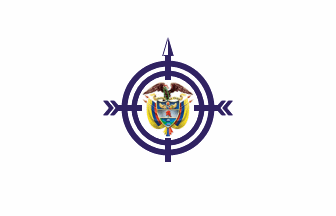
image by Eugene Ipavec, 25 August 2005
The Procuraduría General de la Nación represents the
citizens before the State. It currently has around 3,400
employees and its mission is to oversee the proceedures of the
State, abiding by the laws and the functions it has according to
the 1991 Political Constitution. Its main three goals are: 1.
Preventive function: this goal is directed towards
"alerting" instead of "punishing", watching
over government employees. 2. Intervention function: this is
oriented towards defending the rights on behalf of any Colombian
authority (religious, military, governmental, judiciary, police,
civil, agricultural or any other kind). 3. Disciplinary function:
this goal is focused on the sanctions carried out by violations
of one or multiple individuals who, in office, have carried out
improper activities as government officials.
The flag is the logo with the Colombian Coat of Arms (without the
motto) on white background.
E. R., 30 May and 25 August 2005

image by Eugene Ipavec, 8 March 2006
This is the flag of Registraduría Nacional del Estado Civil
(Civil State National Registry). Official website at <www.registraduria.gov.co>.
This government body is in charge of registring all civilians,
give them their ID's, pass laws regardig these subjects to
Congress, classify and file these information, and also manage
the Consejo Nacional Electoral (National Election Council,
abbreviated CNE, official website at <www.cne.gov.co>). At the
same time the CNE is in charge of all matters related to the
election process in Colombia. The flag of the Registraduría (as
it is commonly known), is a green over white flag (internal ratio
1:1) , pretty much like the flag of the Department of La Guajira, but
the shade of green resembles more that of the flag of the Department of Antioquia, plus
the Coat of Arms on the center.
E. R., 8 March 2006
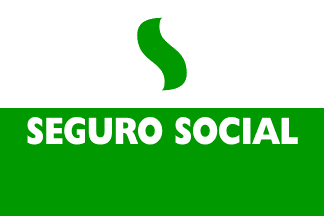
image by Jorge Candeias, 17 April 2004
In a commercial (?) site there is a flag that seems to be the
national security flag. Is it a governmental flag or a commercial
one?
See <clinica_iss_sogamoso.tripod.com.co>.
Dov Gutterman, 19 November 2003
Seguro (Social inssurance) refers surely to a social services
from the state, like health and pensions. Seems that this
hospital is collaborating with the department of Social
inssurance of Colombia
Jaume Olle', 19 November 2003
The Instituto del Seguro Social is a governmental organization
for health care and pension. There are also some private
organizations but this one is public. I don't recall having
seen an actual flag, but I cannot deny it either.
Carlos Thompson, 20 November 2003
The flag is a white-green bicolour with an "S" logo
in the upper field and the name in the top of the lower field.
Jorge Candeias, 17 April 2004
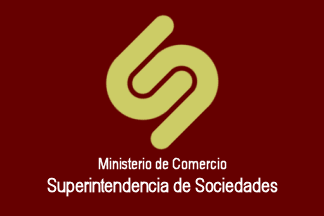
image by Eugene Ipavec, 24 January 2008
The flag of the Superintendencia de Sociedades (Societies
Superintendency), official website at <www.supersociedades.gov.co>.
It is a technical organization of the Colombian government. It is
one of ten such organizations in charge of the inspection,
control and surveillance of its own aspect.
Source: Caracol news channel (<www.caracolnoticas.com>),
TV caps taken on July 25, 2006.
E.R., 24 January 2008

obverse
image by Eugene Ipavec, 24 August 2005

reverse
image by Eugene Ipavec, 10 March 2006
The flag of the Colombian Aviation Authority (its official
name is UAEAC, or Unidad Administrativa Especial Aeronáutica
Civil, or Special Administrative Unit Civil Aeronautics, usually
shortened Aeronáutica Civil or Aerocivil - official website:
<http://www.aerocivil.gov.co>).
E.R., 19 August 2005